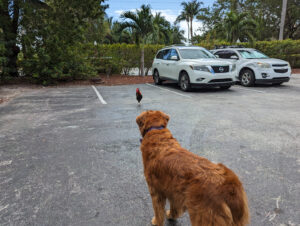Have you ever wondered what the world looks like through your dog’s eyes? What colors can dogs see? Do they see the same colors as you do, or are they color blind? How do they perceive different objects and environments? These are some of the questions that scientists have been trying to answer for decades, and while we do not know everything, we can give you some insights into the fascinating vision of dogs.
Dogs are not color blind, but they see colors differently than humans
One of the most common myths about dog vision is that they only see in black and white. This is not true. Dogs can see colors, but not as many as humans. Humans have three types of color-sensing cells in their eyes, called cones, that allow them to see red, green, and blue colors and their combinations. Dogs, on the other hand, have only two types of cones, that enable them to see yellow and blue colors and their mixtures. This means that dogs have a limited color perception compared to humans, called dichromatic vision.
To illustrate this difference, imagine a rainbow. Humans can see all the colors of the rainbow: red, orange, yellow, green, blue, indigo, and violet. Dogs can only see some of them: yellow, blue-green, and violet. They cannot distinguish between red and green, or orange and yellow. These colors appear as shades of gray or brown to them.
You can use this online tool to see how an image would look like to a dog. Just upload a picture and select the “dog” option to see the difference. This will help answer the question, “What colors can dogs see?”
Dogs have other advantages in their vision that humans do not
While dogs may not see as many colors as humans do, they have other aspects of their vision that give them an edge in certain situations. For example:
- Dogs have more rods than humans in their eyes. Rods are another type of light-sensing cells that are responsible for detecting motion and seeing in dim light. Dogs have about 120 million rods in their eyes, while humans have only about 90 million. This means that dogs can see better than humans in low-light conditions, such as at night or in dark rooms. They can also detect subtle movements more easily than humans.
- Dogs have a wider field of view than humans. The field of view is the angle of vision that an animal can see without moving its head or eyes. Humans have a field of view of about 180 degrees, while dogs have a field of view of about 250 degrees. This means that dogs can see more of their surroundings than humans without turning their heads. This can be useful for hunting, guarding, or avoiding predators.
- Dogs have a faster flicker fusion rate than humans. The flicker fusion rate is the frequency at which a flickering light appears as a steady light to an animal. Humans have a flicker fusion rate of about 60 Hz, while dogs have a flicker fusion rate of about 80 Hz. This means that dogs can perceive images on a screen faster than humans. For example, a TV show or a movie that looks smooth to us may look choppy or flickering to a dog.
How to choose the best toys and accessories for your dog based on their vision
Knowing how your dog sees the world can help you make better choices for their toys and accessories. Here are some tips to keep in mind:
- Choose toys that are yellow or blue in color. These are the colors that your dog can see best and will be more attractive to them. Avoid toys that are red or green in color, as they will appear dull or gray to your dog.
- Choose toys that contrast well with the background. For example, if you are playing with your dog on grass, avoid green toys and opt for yellow or blue ones instead. This will make it easier for your dog to spot and chase the toy.
- Choose toys that make noise or have texture. Since dogs rely more on their hearing and smell than their sight, toys that make sounds or have different textures can stimulate their senses and keep them interested.
- Choose collars and leashes that are bright and reflective. This will make your dog more visible to you and others, especially in low-light conditions or busy areas. You can also use LED lights or glow-in-the-dark accessories for extra safety.
Conclusion
Dogs may not see the world in the same way as humans do, but they have a unique and amazing vision that suits their needs and abilities. By understanding how your dog sees the world, you can enrich their lives and bond with them better. Remember, dogs are not color blind, but they see colors differently than humans. They can see yellow and blue colors, but not red and green. They also have other advantages in their vision, such as seeing better in low light, having a wider field of view, and perceiving images faster. You can choose the best toys and accessories for your dog based on their vision, such as yellow or blue toys that contrast well with the background, toys that make noise or have texture, and collars and leashes that are bright and reflective.


